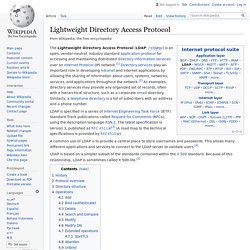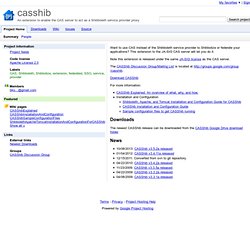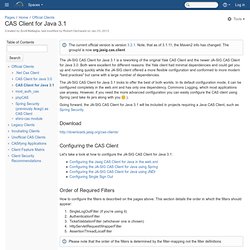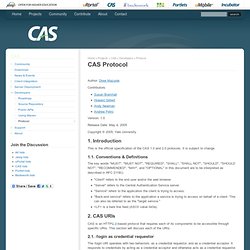

Protocole LDAP. The Lightweight Directory Access Protocol (LDAP; /ˈɛldæp/) is an open, vendor-neutral, industry standard application protocol for accessing and maintaining distributed directory information services over an Internet Protocol (IP) network.[1] Directory services play an important role in developing intranet and Internet applications by allowing the sharing of information about users, systems, networks, services, and applications throughout the network.[2] As examples, directory services may provide any organized set of records, often with a hierarchical structure, such as a corporate email directory.

Similarly, a telephone directory is a list of subscribers with an address and a phone number. LDAP is specified in a series of Internet Engineering Task Force (IETF) Standard Track publications called Request for Comments (RFCs), using the description language ASN.1. A common use of LDAP is to provide a central place to store usernames and passwords. History[edit] Protocol overview[edit] scope. OpenDS. Offre IAM Oracle.
OpenLDAP. ENT Toutatice. Autentification, registration, identity. CASShib. Want to use CAS instead of the Shibboleth service provider to Shibbolize or federate your applications?

This extension to the JA-SIG CAS server will let you do it. Note this extension is released under the same JA-SIG license as the CAS server. The CASShib Discussion Group/Mailing List is located at Download CASShib For more information: Downloads The newest CASShib release can be downloaded from the CASShib Google Drive download folder. News. CAS User Manual. The CAS User Manual is the primary source of documentation for implementers of the Jasig CAS server component.

For readers unfamiliar with CAS, the Overall Architecture section is a good starting point to learn what CAS is and how it works. Readers will learn that CAS is a multi-protocol SSO solution and they will want to review protocols to learn the use cases under which a particular protocol applies. Once review of background material is complete, readers should consider working through the CAS demonstration, which will provide a working product and an introduction to configuration.
There are a few fundamental considerations to CAS configuration: Integration with an authentication provider Security policy Authorization Availability considerations Attribute release Authentication CAS integrates with the following authentication mechanisms: Security Policy Ticket-granting tickets (TGT) that expire after more than 2 hours of inactivity. Authorization Availability Default is Not Distributed Icon.
Proxy CAS. A manual walkthrough of CAS proxy tickets.

This walkthrough was provided by David Spencer on the CAS Mailman list. When I was trying to understand the mechanisms involved in writing proxying applications using CAS, I found it very helpful to manually walkthrough the aquisition of a proxy ticket. The CAS server played itself in this exercise and I played all the other roles - user, proxying application and proxied application - simply by constructing URLs and feeding them into a web browser.
The only part of the exercise that can't be done with just a web browser and careful URL construction is the part where CAS makes it's own callback to the proxying application. For this, I chose a proxy callback url on a machine for which I had access to the log files and scanned through the HTTP requests to find the information I wanted. Step One: login To start with, log in to CAS with some invented service: Step Two (a): verify the ticket and be done which will produce a result like: results in: Animation. Legacy Clients. CAS Client for Java 3.1. Icon The current official version is version 3.2.1.

Note, that as of 3.1.11, the Maven2 info has changed. The groupId is now org.jasig.cas.client The JA-SIG CAS Client for Java 3.1 is a reworking of the original Yale CAS Client and the newer JA-SIG CAS Client for Java 3.0. Both were excellent for different reasons: the Yale client had minimal dependencies and could get you up and running quickly while the JA-SIG client offered a more flexible configuration and conformed to more modern "best practices" but came with a large number of dependencies.
Shibboleth 2.x - Confluence. Skip to end of metadataGo to start of metadata Shibboleth allows users to securely send trusted information about themselves to remote resources.

This information may then be used for authentication, authorization, content personalization, and enabling single sign-on across a broad range of services from many different providers. The current stable release of the Identity Provider is V2.4.0. There are no previous stable releases at this time. The current stable release of the Service Provider is V2.5.3. Icon The minimum safe release versions that don't contain critical security issues are V2.3.6 of the IdP and V2.5.2 of the SP (in the latter case, you must ensure various libraries are also sufficiently new).
Shibboleth V1.3.x and earlier releases of the Identity Provider and Service Provider are unsupported. All software, including archived releases, is available from and each release is accompanied by a detached PGP signature using one of the keys listed in the project's KEYS file. CAS Protocol. Author: Drew Mazurek Contributors: Version: 1.0 Release Date: May 4, 2005 Copyright © 2005, Yale University.

CASifying Applications.